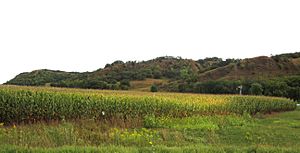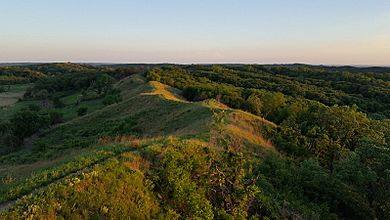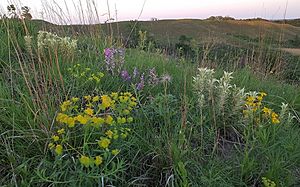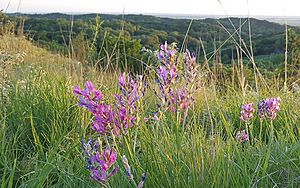Loess Hills facts for kids
Quick facts for kids Loess Hills |
|
|---|---|

Loess Hills east of Mondamin, Iowa.
|
|
| Location | Western Iowa and Missouri, U.S. |
| Designated | 1986 |
The Loess Hills are a special kind of land formation. They are made of fine, wind-blown soil called loess. You can find them in western Iowa and Missouri, and eastern Nebraska and Kansas. These unique hills stretch along the Missouri River.
Contents
How the Loess Hills Formed
The Loess Hills are usually found about 1 to 15 miles east of the Missouri River. They rise up to 200 feet above the flat plains. These hills form a narrow band that runs for 200 miles along the river. They are like the first "front range" of hills you see beyond the flat river lands in Iowa, Missouri, and Nebraska.
These hills were created during the last Ice Age. Huge glaciers moved across North America. As they moved, they ground rocks into a fine dust, like "glacial flour." When the weather got warmer, the glaciers melted. Lots of water and sediment flowed into the Missouri River Valley. This sediment settled on the flat flood plain, creating huge mud flats.
When the meltwater dried up, these mud flats were left exposed. Strong winds from the west picked up the fine, dry silt. Giant dust clouds formed and dropped this soil over large areas. The heavier silt fell closer to the Missouri River, making huge dunes. Over time, grass grew and held these dunes in place. Because loess soil can stand in tall, vertical columns when dry, the wind and rain slowly carved these stabilized dunes into the bumpy, sharp hills we see today.
The Loess Hills have unique shapes. You'll see "peak and saddle" areas, which look like a horse's back. There are also "razor ridges," which are very narrow, sometimes less than 10 feet wide. These ridges can drop steeply on both sides for 60 feet or more! You might also notice "cat-step" terraces. These are small, step-like ledges caused by the soil slowly sliding down. The soil is usually yellow and is sometimes called "sugar clay." This is because it's very hard when dry but loses its shape when wet. The Loess Hills in Iowa are amazing because the loess layer is often more than 90 feet deep! Only one other place in the world has such deep loess deposits: Shaanxi, China.
Where to Find the Loess Hills
Today, the Loess Hills stretch from Blood Run Site in South Dakota down to Mound City, Missouri. You can also find loess landforms in eastern Nebraska and Kansas along the Missouri River. Some cities near these hills include Brownville, Rulo, and Ponca in Nebraska, and Hamburg and Sidney in Iowa. South Dakota has three state parks with loess formations: Union Grove State Park, Newton Hills State Park, and Blood Run State Park. These are all south of Sioux Falls. The hills are usually about 200 feet above the Missouri River bottoms. But in some places, like Murray Hill in Iowa, they can rise over 350 feet!
Plants and Animals of the Loess Hills
The Loess Hills are home to many different plants and animals. They have thick oak-hickory forests and some of the last natural prairie grass areas in the region. However, some plants like red cedar, which are not native, are growing into the prairie and forest areas. This can harm the fragile soils and the natural ecosystems.
The native prairie areas have tall grasses like big bluestem and little bluestem, and other plants like Indian grass and sideoats grama. You can also find wildflowers such as yucca, pasque flower, and lead plant. Many of these prairie plants are usually found further west, like the spiny-leafed yucca and prickly pear cactus. In 1984, a new type of fern, the Prairie Moonwort, was found here. Scientists think it only grows in the Loess Hills.
Today, you can see animals like white-tail deer, coyotes, wild turkeys, badgers, bobcats, and red and gray foxes. You might also spot ringneck pheasants, bobwhites, and red-tailed hawks. Some of these animals were brought here or encouraged by early settlers. As forests grow bigger due to less fire, animals that live in forests are also increasing.
Some animals that used to live here, like the prairie rattlesnake, great plains skink, and ornate box turtle, are becoming rare. This is because their homes are being broken up by new buildings and less fire in the prairies. However, animals like bobcats are making a comeback. Even mountain lions have been seen in Southwest Iowa recently! Long ago, animals like American bison, prairie chicken, and gray wolfs also lived here, but they disappeared by the late 1800s.
The Missouri River valley used to be a major path for migrating birds. But changes to the river and the loss of wetlands have caused fewer birds to use it. Still, it's one of the best places to watch raptors (birds of prey) migrate. As air moves off the Great Plains, it sinks into the Missouri River valley. When the wind hits the Loess Hills, it creates rising air currents called "thermals." Raptors use these thermals to fly to and from their breeding grounds. You can often see many raptors circling together in a "kettle" as they use the same thermal.
From September to December, you might see red-tailed hawks, sharp-shinned hawks, peregrine falcons, Cooper's hawks, ospreys, northern harriers, American kestrels, and bald eagles. Since the Hitchcock Nature Center HawkWatch started, 20 different kinds of raptors have been seen in one season! In 2005, a record 16,000 birds were counted. The Broken Kettle Grasslands Preserve in the northern Loess Hills is the only place in Iowa where black-billed magpies nest. It's also home to the last known group of prairie rattlesnakes in Iowa.
Fun Things to Do in the Loess Hills


The Loess Hills Scenic Byway is a road that offers many beautiful views from Westfield, Iowa, to Hamburg. Even though most of the land is privately owned, there are thousands of acres of public land. These include state and county parks, wildlife areas, and nature preserves. The Nature Conservancy also owns several areas open to the public, like the Broken Kettle Grasslands Preserve. This is the largest continuous area of native prairie left in Iowa.
The Loess Hills State Forest is in western Iowa. It has four sections that cover about 10,600 acres. Here, you can go hiking, backpacking, picnicking, and fishing. Preparation Canyon State Park is a less developed park within the Loess Hills State Forest. It covers 344 acres and was once a Mormon village. It has trails for backpacking and campsites you can hike to. Two main state parks are at the ends of the hills: Waubonsie in the south and Stone in the north. Both offer camping and other fun activities.
Hitchcock Nature Center is run by the Pottawattamie County Conservation Board. It has a lodge with a platform for watching raptors and an observation tower. From the tower, you can see amazing views of the Hills, the Missouri River valley, and the skyline of downtown Omaha, Nebraska. You can also go hike-in camping here.
Two special places in the Loess Hills are called National Natural Landmarks. The Little Sioux/Smith Lake Site covers 2,980 acres and is a great example of the unique hills made by loess soil. The Turin Site of the Loess Hills National Natural Landmark is 7,440 acres. It also includes the Turin Man prehistoric archeological site, where ancient human remains were found.
Human History in the Loess Hills
The Loess Hills have a long and interesting human history. The hills around Glenwood were once home to the Glenwood culture. These people lived here from about 900 A.D. to 1300 A.D. They built hundreds of earth lodges (houses dug partly into the ground) and farmed the rich valley lands. They also gathered native plants from the hills. Today, you can see a replica of an earth lodge in Glenwood Lake Park. The Mills County Museum, also at the park, has many artifacts found by a famous amateur archeologist named Paul Rowe.
The city of Council Bluffs, Iowa got its name from these hills. It was named after the first official "council," or meeting, that the Lewis and Clark explorers had with Native Americans in 1804. This meeting was with the Oto and Missouri tribes. However, the meeting actually happened on the Nebraska side of the Missouri River. Sgt. Charles Floyd, the only person to die during the Lewis and Clark Expedition, is buried on a bluff in the Loess Hills in what is now Sioux City, Iowa.
In 1853, a Mormon leader named Charles B. Thompson led some Mormon families to Kanesville. Thompson and others then chose an area called Monona, meaning "peaceful valley." They founded the town of Preparation there. Thompson later told people that a "spirit" told them to give all their property to him. In 1856, the people wanted their property back. Thompson refused, and they confronted him. Thompson escaped and later left Iowa.
On August 12, 1859, Abraham Lincoln visited the hills at Cemetery Hill in Council Bluffs. He was learning about possible places for the First Transcontinental Railroad.
Images for kids








